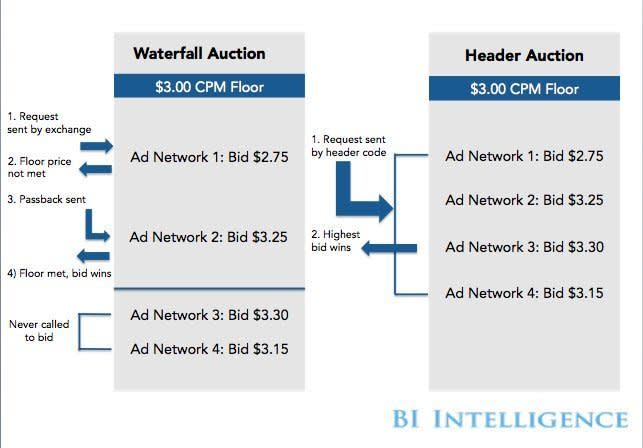Facebook forays into header bidding (FB)

BI Intelligence
This story was delivered to BI Intelligence "Digital Media Briefing" subscribers. To learn more and subscribe, please click here.
Facebook has confirmed the integration of header bidding technology with six ad tech companies, according to The Drum.
Header bidding allows publishers to open up their ad space to more advertisers and levels the playing field for advertisers to bid on this inventory. In addition, header bidding improves upon programmatic auctions. While programmatic auctions accept a bid once it hits a minimum threshold, header bidding allows publishers to collect bids and then select the highest offer.
Here are a few observations:
The partners. Facebook's initial partners include Amazon Publisher Services, AppNexus, Index Exchange, Media.net, Sonobi, and Sortable. The inclusion of Amazon is particularly interesting as the two media giants could be partnering to take on the competing walled garden, Google, which also has header bidding technology built into their ad-buying software.
Publishers can make more money. Due to the advanced bidding process, publishers can earn 10%-30% more ad revenue using header bidding over traditional programmatic auctions.
Header bidding adoption debacle. AppNexus estimated that 70% of comScore’s top 200 publishers are using header bidding technology in 2016. However, a new analysis from ad tech firm GetIntent suggests just 12% of the top 1,000 websites on Alexa.com have implemented header bidding. The discrepancy highlights that the header bidding opportunity may be larger than previously disclosed estimates.
Improving industry relations. Facebook is widely accused of being a walled garden because of its control over the advertiser experience on its platforms. Opening up the header bidding technology to third-party ad tech vendors signals Facebook’s willingness to become more transparent.
Header bidding can be highly lucrative for publishers that are able to correctly implement the solution. Benefits include yield optimization and potential increased revenue, as well as fewer pass backs (when an ad network or exchange cannot fill an impression and sends the request back to the server). It also offers increased transparency in inventory value and allows publishers to bypasses Google's DoubleClick For Publishers (DFP) favoritism for its own ad exchange, AdX.
Header bidding is a relatively new phenomenon, but it has picked up momentum among publishers. And there's plenty more to learn about this technology.
BI Intelligence, Business Insider’s premium research service, has compiled a detailed report on header bidding that explains how it works through graphics that illustrate the process. It also takes a look at how publishers benefit from integrating third-party header code on their webpages and explains how it can be advantageous for buyers when real-time bidding (RTB) technology takes place first — and not last — in the auction.
The report discusses some of the hurdles that prevent sellers from adopting header bidding, including technical implementation and latency issues, and lay out how header wrappers aim to alleviate some of these pain points. Finally, it takes a look at how widespread adoption of header bidding could impact the future of guaranteed buys and ad networks.
Here are some key takeaways from the report:
Publishers are rapidly adopting header bidding technology. Nearly 70% of publishers now use header bidding technology, according to Tom Shields, SVP of publisher strategy at AppNexus. This is up from a negligible number two years ago.
The technology offers many benefits for publishers and advertisers. For publishers, header bidding offers a means to optimize yield, cut down on passbacks, increase transparency of inventory value, and eliminate Google's favoritism for its own ad exchange, AdX. On the buy side, advertisers are given the opportunity to bid on all available inventory and not just remnant inventory like in a waterfall system.
But header bidding requires advanced technical implementation and could lead to increased latency issues. To make up for this, many header code providers are creating header wrappers that cut back on operational hurdles when publishers use multiple header providers and offer timeout settings to ease latency problems.
In full, the report:
Defines header bidding.
Illustrates the header bidding process.
Compares header bidding to the traditional waterfall auction in programmatic.
Details the advantages that header bidding gives both buyers and sellers.
Explains some of the hurdles that publishers have to address when implementing a header bidding strategy.
Poses questions on the long-term effects of header bidding on the programmatic ecosystem.
To get your copy of this invaluable guide, choose one of these options:
Subscribe to an ALL-ACCESS Membership with BI Intelligence and gain immediate access to this report AND over 100 other expertly researched deep-dive reports, subscriptions to all of our daily newsletters, and much more. >> START A MEMBERSHIP
Purchase the report and download it immediately from our research store. >> BUY THE REPORT
The choice is yours. But however you decide to acquire this report, you’ve given yourself a powerful advantage in your understanding of header bidding technology.
See Also:

 Yahoo News
Yahoo News 

